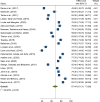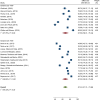Prevalence and contributing factors of early initiation of breastfeeding (EIBF) in Ethiopia: a systematic review and meta-analysis
- PMID: 40221719
- PMCID: PMC11992844
- DOI: 10.1186/s12889-025-22568-9
Prevalence and contributing factors of early initiation of breastfeeding (EIBF) in Ethiopia: a systematic review and meta-analysis
Abstract
Background: Even though the National Infant and Young Child (IYC) Feeding guideline was launched in Ethiopia in 2016, early initiation of breastfeeding is not consistently measured among studies which limit evidence for the development of promotion strategies.
Methods: A weighted inverse-variance random effects model was used to estimate the pooled prevalence and contributing factors of early initiation of breastfeeding (EIBF). Heterogeneity was assessed using the I² statistic, forest plot, and Egger's test. Data from 22 primary studies across all regional states in Ethiopia were analyzed, including 39,316 mother-infant pairs who had given birth and breastfed within the last two years, from December 11, 2023, to January 16, 2024.
Results: The pooled prevalence of EIBF was 67.44% (95% CI: 61.31-73.56, I² = 99.40%, P = 0.001). Factors contributing to EIBF included urban residency (OR = 2.7, 95% CI: 2.11-3.30), regular antenatal care (OR = 2.44, 95% CI: 1.72-3.15), absence of prelacteal feeding (OR = 4.26, 95% CI: 2.93-5.60), secondary or higher education (OR = 2.53, 95% CI: 1.39-3.68), highest maternal wealth index (OR = 2.36, 95% CI: 1.62-3.09), health facility delivery (OR = 3.60, 95% CI: 2.58-4.62), receiving health education during antenatal care (OR = 1.62, 95% CI: 1.40-1.84), and breastfeeding support (OR = 3.56, 95% CI: 2.38-4.73).
Conclusion: The prevalence of early breastfeeding initiation (EIBF) remains below WHO targets. Factors like urban residence, higher education, and access to antenatal care and hospital-based delivery services are positively linked to EIBF. To improve rates, health services should enhance community outreach, promote antenatal care, provide early breastfeeding education, and offer professional support immediately after birth.
Prospero id: CRD42024498671.
Keywords: Antenatal care; Breastfeeding counseling; Early (timely) initiation of breastfeeding; Exclusive breastfeeding; Health education.
© 2025. The Author(s).
Conflict of interest statement
Declarations. Human Ethics and Consent to Participate: Not applicable. Patient and public involvement: Patients and/or the public were involved in the design, or conduct, or reporting, or dissemination plans of this systematic review and meta-analysis. Competing interests: The authors declare no competing interests.
Figures






References
-
- Blyth R, Hons M, Creedy DK, Dennis C, Moyle W, Rn JP. Effect of maternal confidence on breastfeeding duration: an application of breastfeeding self-efficacy theory. Int J Nurs Stud. 2002;39(3):278–84. - PubMed
-
- Ekwueme MC, Young MF. Breastfeeding experiences, barriers, and facilitators among mothers of vulnerable low birth weight infants in Amhara region, Ethiopia: A qualitative exploratory study. BMC Pregnancy Childbirth. 2023;23:1–23. - PubMed
Publication types
MeSH terms
LinkOut - more resources
Full Text Sources
Medical

